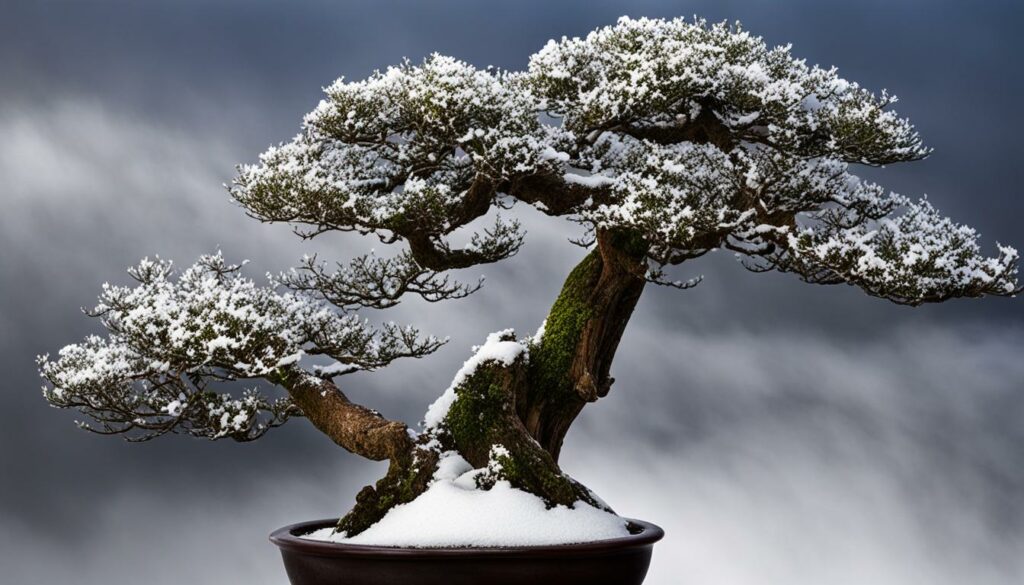If you are a fan of indoor bonsai trees, you must have come across the Serissa Bonsai, also known as Snow Rose Bonsai. The delicate yet enchanting tree is known for its small leaves and beautiful flowers, which make it an excellent choice for indoor cultivation. Furthermore, Serissa Bonsai is an excellent project for novice gardeners and seasoned horticulturalists looking for a challenge alike.
The Serissa Bonsai originated from Southeast Asia, and it belongs to the Rubiaceae family. This family comprises approximately 500 species, and the Serissa Foetida species is the most popular among bonsai enthusiasts. Growing a healthy and vibrant Serissa Bonsai tree requires a combination of patience, care, and specific techniques. In the subsequent sections, we will explore the various aspects of Serissa Bonsai tree cultivation in detail.
Key Takeaways
- Serissa Bonsai is a delicate and enchanting indoor tree species perfect for novice gardeners and seasoned horticulturalists alike.
- It belongs to the Rubiaceae family and originates from Southeast Asia.
- Successful cultivation of Serissa Bonsai requires patience, care, and specific techniques.
Understanding the Serissa Bonsai Tree Species
The Serissa bonsai tree species is a captivating plant with a rich history. The Serissa tree is native to East Asia, including Japan, China, and Southeast Asia. The botanical name of this plant is Serissa foetida, but it is commonly known as the snow rose due to its delicate and beautiful white flowers.
The Serissa bonsai tree is small, growing only up to 25 cm in height. It has small, dark green leaves that are often paired with tiny white flowers. The tree’s bark is thin and smooth, making it easy to shape, prune, and train.
If you’re looking for a bonsai tree that is easy to care for, the Serissa might be the perfect choice for you. However, be careful not to overwater this delicate tree as it is susceptible to root rot.
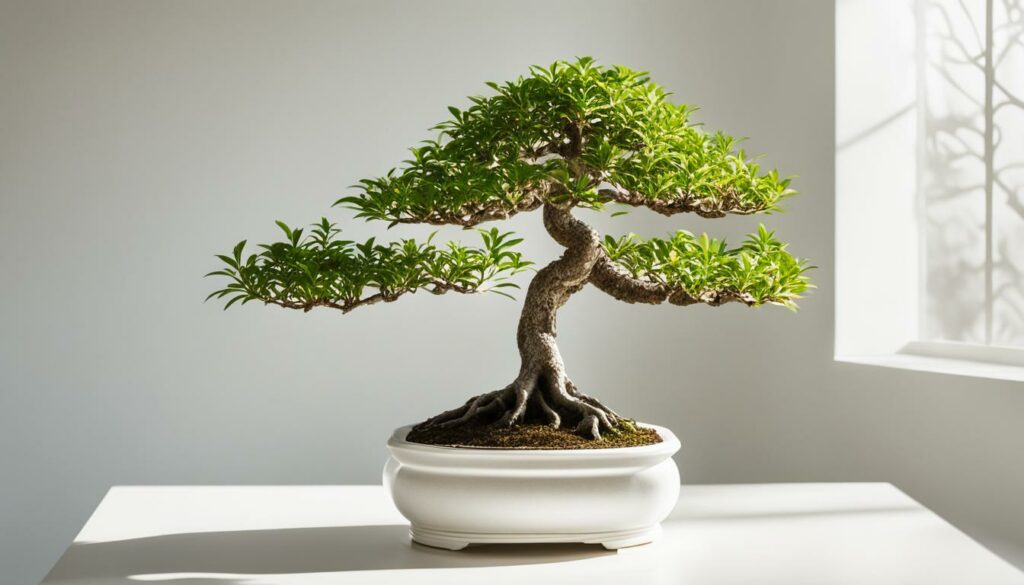
Distinct features of Serissa Bonsai Trees
What sets the Serissa bonsai tree apart from other bonsai species is its distinct features. The tree has small leaves that give the impression of a forest in a miniature form. It has white or pink flowers that bloom profusely throughout the year, adding to its aesthetic value.
Additionally, the Serissa bonsai tree is known for its easy maintenance and adaptability. It can withstand a variety of temperatures, as long as it is not exposed to frost or extremely cold conditions. With proper care and maintenance, the tree can live for many years, making it a great choice for indoor bonsai enthusiasts.
Origin and Characteristics of Serissa Bonsai Trees
| Origin of Serissa Bonsai Trees | Characteristics of Serissa Bonsai Trees |
|---|---|
| The Serissa bonsai tree is native to East Asia, including Japan, China, and Southeast Asia. | The Serissa bonsai tree is small, growing only up to 25 cm in height. It has small, dark green leaves that are often paired with tiny white flowers. The tree’s bark is thin and smooth, making it easy to shape, prune, and train. |
The Serissa bonsai tree is a fascinating plant that has taken the world by storm. Its unique features, easy maintenance, and adaptability make it a popular choice for indoor bonsai enthusiasts. Whether you’re a beginner or an experienced bonsai enthusiast, the Serissa bonsai tree is a great addition to any indoor garden.
The Beauty of the Snow Rose Bonsai
Indoor bonsai enthusiasts adore the snow rose bonsai for its delicate flowers and small leaves. This delightful tree is sure to bring a touch of beauty and grace to any indoor space. Its small white or pink flowers with a yellow center bloom in late spring and throughout the summer. These blossoms, along with its small and glossy leaves, make the snow rose bonsai an excellent choice for indoor gardening.
To support healthy growth, ensure that the snow rose bonsai is placed in a bright location. Ideally, it should receive several hours of morning or late afternoon sunlight. Too much direct sunlight or a lack of water can lead to leaf yellowing or dropping.
Tips: To maintain the snow rose bonsai’s small size and enhanced beauty, frequent pruning may be required. Avoid over-watering, which can lead to root rot or leaf drop.
It’s essential to provide the right growing environment for the snow rose bonsai to thrive. A suitable soil composition, frequent fertilization, and regular pruning are elements of successful cultivation. Careful attention to these details will ensure that your snow rose bonsai brings joy and beauty to you and your home for years to come.
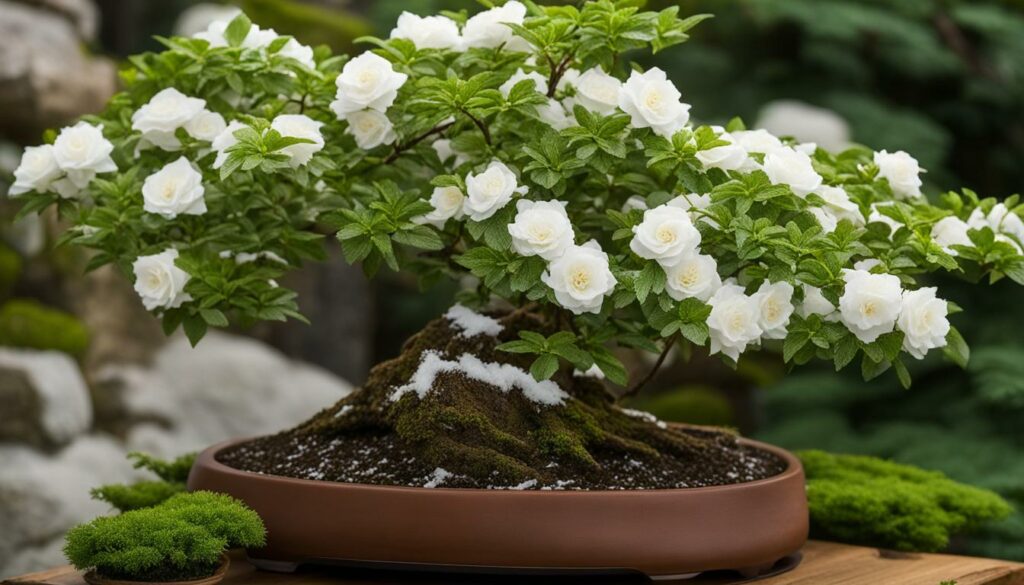
Snow Rose Bonsai Care Tips
| Aspect | Care Tips |
|---|---|
| Lighting | Place the snow rose bonsai in a bright location with several hours of indirect sunlight. |
| Watering | Avoid over-watering, which can lead to root rot or leaf drop. Water the tree when the soil is slightly dry to the touch. |
| Soil | Use well-draining soil with a mix of peat moss, perlite, and sand to promote healthy growth. |
| Pruning and Shaping | Regular pruning and shaping can maintain the bonsai’s small size, promote healthy growth, and enhance its beauty. |
| Fertilizing | Fertilize with a slow-release fertilizer in early spring and mid-summer to support healthy growth. |
The Art of Growing Serissa Bonsai Trees
If you’re looking to grow Serissa bonsai trees, there are a few secrets to ensure the success of your indoor bonsai.
The Serissa bonsai tree, also known as Serissa foetida, prefers bright, indirect light and temperatures between 50-70°F. Keep in mind that cold drafts near windows can harm the bonsai, so place it in a protected area.
Watering the Serissa bonsai is crucial for its health, and it requires moist soil. Watering once a week is suggested, but you may need to increase the frequency during hot and dry periods. Ensure the water runs through the soil and out the holes in the base to avoid waterlogging the roots.
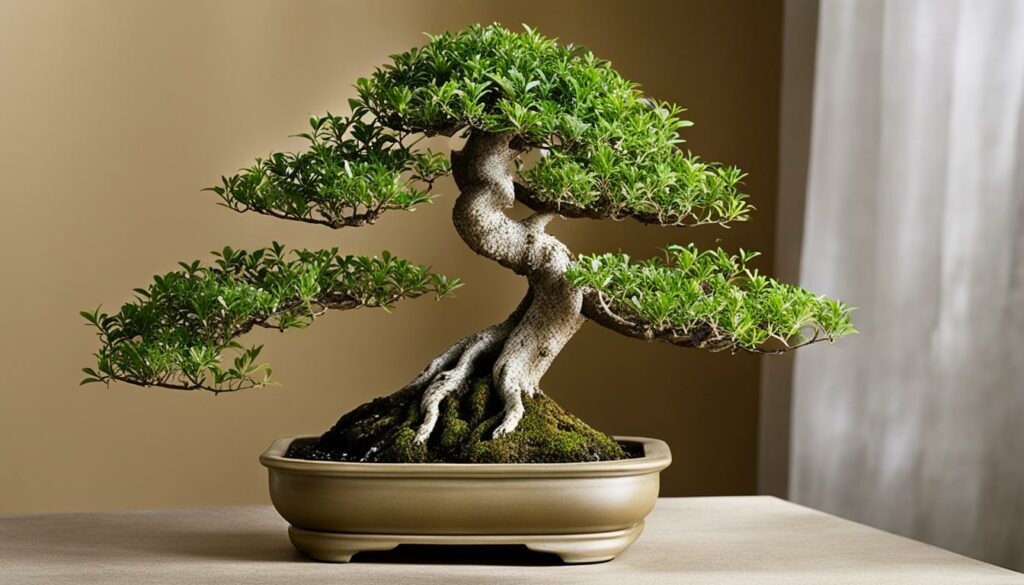
Pruning is an essential aspect of maintaining your Serissa bonsai tree’s health, shape, and size. The best time to prune is late winter or early spring, just before new growth begins. Use sterilized, sharp scissors or pruning shears, and only remove up to one-third of the tree’s foliage at a time.
Tip: Keep in mind that Serissa bonsai trees are naturally delicate and tender, so be careful not to over-prune or damage the branches.
Fertilizing your Serissa bonsai helps it thrive and produce its delightful white or pink flowers. Use a balanced fertilizer, such as 10-10-10, and apply it every two to three weeks during the growing season.
Keep the soil slightly acidic, with pH levels between 5.5 and 6.5, to ensure the plant’s health. When repotting your Serissa bonsai, use specific bonsai soil to encourage proper drainage, moisture, and healthy root development.
By mastering these tips, you can cultivate a beautiful Serissa bonsai tree that thrives indoors and catches everyone’s attention.
Pruning and Shaping Serissa Bonsai Trees
To create your desired shape and form, pruning and shaping Serissa bonsai trees requires time and patience. When to prune and how much to prune depends on the tree’s growth habits and its current size. The best time to prune is in early spring when new growth begins, allowing the tree adequate time to recover and grow.
Before you prune, it’s essential to choose the right tools. A pair of sharp pruning shears or scissors and concave cutters can provide you with the precision needed for successful bonsai pruning.
When pruning, always sterilize your tools to prevent the spread of disease and infection. To create a natural-looking shape, start by removing any dead or unhealthy branches at the bottom of the tree and work your way up. Repeatedly trimming new growth will result in a compact, well-proportioned bonsai with attractive foliage and blossoms.
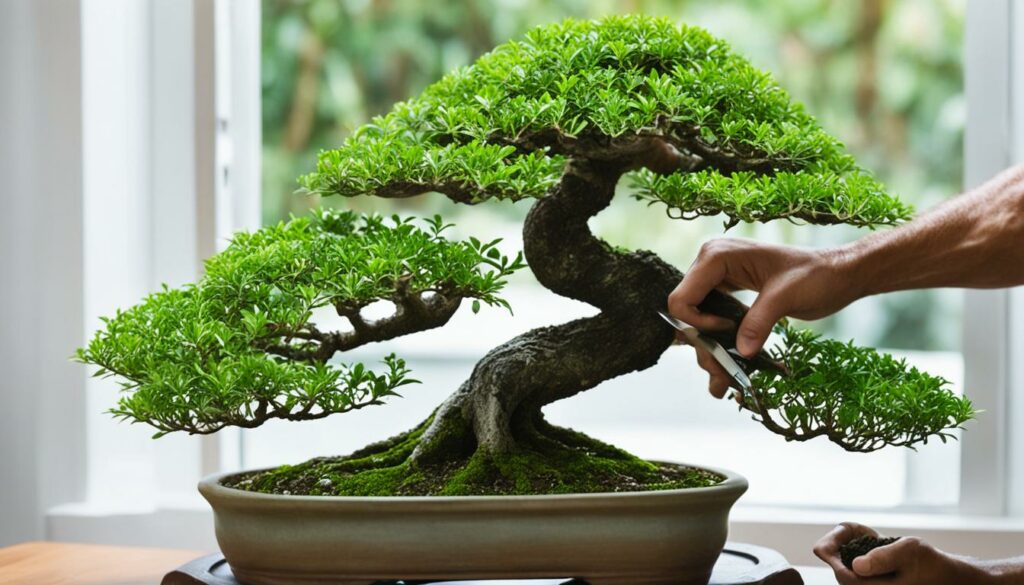
Tip: While pruning, keep an eye on your bonsai’s shape and balance. A well-managed and visually appealing tree should have a tapered trunk and branches that decrease in size as you move upwards towards the apex.
Overcoming Common Challenges in Serissa Bonsai Care
Caring for Serissa bonsai trees requires attention to detail and proper techniques. Despite your best efforts, common challenges can arise that affect the health and growth of your tree.
Here are some common issues that bonsai enthusiasts face when caring for Serissa bonsai trees:
| Challenge | Solution |
|---|---|
| Pest infestations such as spider mites, whiteflies, and scale insects | Regularly check your tree for signs of pests and treat immediately with a suitable pesticide. Increase air circulation around your tree to prevent the buildup of pests. |
| Fungal diseases such as powdery mildew and root rot | Avoid overwatering your tree and ensure proper drainage. Treat any fungal infections with a suitable fungicide and remove any infected leaves or branches. |
| Improper watering | Follow the watering guidelines for Serissa bonsai trees, allowing the soil to dry slightly between waterings. Use the right watering techniques to avoid damaging the delicate roots of your tree. |
Remember, prevention is key to maintaining the health of your Serissa bonsai tree. Regularly inspect your tree, provide proper care, and promptly address any issues that arise.
By overcoming common challenges and providing proper care, your Serissa bonsai tree will continue to thrive and bring beauty to your indoor space.
Repotting and Soil Considerations for Serissa Bonsai
Repotting is an essential task for maintaining the health and vitality of your Serissa bonsai tree. Typically, the best time to repot your bonsai is in the spring when the tree is starting to grow again. When repotting, it is crucial to consider the soil mix that you use, as the right soil mixture is essential for the growth of your bonsai.
Serissa bonsai trees prefer well-draining soil that is rich in organic matter, such as peat moss or compost. Ensure that the potting mixture contains equal amounts of loam and sand to provide the necessary drainage and aeration required by the tree’s roots.
If you notice that your Serissa bonsai tree’s growth has slowed down, it may be time to repot it. Carefully remove the tree from its pot and shake the old soil from its roots. Trim any damaged or dead roots, and then safely place the tree in the new pot, ensuring that the roots are not too crowded. Fill the pot with fresh soil and water the bonsai immediately to prevent air pockets from forming.
| Step | Instructions |
|---|---|
| Step 1 | Water your bonsai tree the day before repotting, ensuring that the soil is moist, but not soaking wet. |
| Step 2 | Remove the tree from its pot and remove as much of the old soil as possible without damaging the roots. |
| Step 3 | If the roots are growing in a circular pattern, carefully untangle them and trim off any damaged or dead roots. |
| Step 4 | Place the tree in the new pot and add soil around the roots, packing it firmly but gently to avoid air pockets. |
| Step 5 | Water the bonsai tree and keep it in a partially shaded area for a week or two to allow the roots to recover. |
Remember to repot your Serissa bonsai every two to three years to ensure optimum growth and health. With the proper soil mix and repotting techniques, your Serissa bonsai will flourish and bring beauty to your indoor space.
Winter Care and Protection for Serissa Bonsai
As winter approaches, it’s important to take special care of your Serissa bonsai tree. The delicate nature of the snow rose bonsai makes it vulnerable to cold temperatures, so it’s essential to protect it from frost and other winter hazards. Here are some tips for keeping your Serissa bonsai healthy and vibrant during the colder months:
1. Keep the Tree Indoors
Serissa bonsai trees are primarily indoor plants. During winter, they should be kept indoors with sufficient sunshine and adequate humidity. You can place it near a window that receives considerable sunlight. It is important to avoid exposing the tree to cold drafts, such as those caused by open windows or air conditioning.
2. Protect from Low Temperatures
Serissa bonsai trees are particularly sensitive to cold temperatures. The ideal temperature for Serissa bonsai is between 60°F to 75°F (16°C to 24°C), and lower temperature can cause damage or death to the plant. To protect your Serissa bonsai, you can cover it with a light blanket or a protective cover or place it in a room with consistent temperature.
3. Reduce Watering
In winter, the tree does not require as much watering as during the warmer months, because its metabolic processes are slower. Therefore, you should reduce watering to prevent waterlogging and root rot. It is advisable to keep a consistent watering schedule and allow the soil to dry out partially before watering.
4. Prevent Pests and Diseases
Serissa bonsai trees can be susceptible to pests and diseases during winter months due to reduced ventilation and airflow. You can preventive measures by inspecting the tree regularly, avoiding overwatering and controlling humidity levels, and using organic or chemical solutions if necessary. Furthermore, cleaning the tree and pruning infected parts can help prevent the spread of disease and pests.
By following these winter care tips and protection guidelines, you can ensure the health and longevity of your Serissa bonsai tree during the colder months. Remember to monitor your tree frequently and adjust your care routine as needed to maintain its beauty and vigor.
Conclusion
You have now gained a thorough insight into the delicate Serissa bonsai tree species, also known as the snow rose. As an indoor bonsai enthusiast, you can appreciate the unique characteristics and care tips required for cultivating this beautiful species.
Remember, the Serissa bonsai tree requires adequate sunlight, humidity, and drainage to thrive. You need to water the plant regularly and provide the correct fertilizer for optimal growth. Pruning and shaping the tree will help you create the desired form and style.
However, be mindful of the common challenges that you may face when caring for the Serissa bonsai tree. You must prevent and overcome issues such as pests, diseases, and improper care.
Furthermore, Winter care and protection are crucial for the survival of the Serissa bonsai tree. You need to shield the tree from cold temperatures while maintaining its health and vigor.
In conclusion, the Serissa bonsai tree embodies exquisite beauty and intricacy. With proper care and attention, you can enjoy the allure of this indoor bonsai tree for many years to come.
FAQ
What is the Serissa bonsai tree species?
The Serissa bonsai tree species, also known as the snow rose, is a delicate indoor bonsai tree that is prized for its small leaves and beautiful flowers.
Where does the Serissa bonsai tree species originate from?
The Serissa bonsai tree species is native to Southeast Asia, particularly China and Japan. It has been cultivated and cherished for centuries in these regions.
Why is the Serissa bonsai tree also called the snow rose?
The Serissa bonsai tree is often referred to as the snow rose because of its small, delicate white flowers that resemble miniature roses. These flowers add to its overall charm and beauty.
What are the ideal conditions for growing Serissa bonsai trees?
Serissa bonsai trees thrive in warm and humid conditions. They prefer partial sunlight and should be protected from strong winds. It is important to provide them with consistent moisture levels and well-draining soil.
How should I prune and shape my Serissa bonsai tree?
Pruning and shaping Serissa bonsai trees is best done during the growing season. Use sharp bonsai pruning shears to remove unwanted branches and encourage new growth. You can also wire the branches to create desired forms and styles.
What are some common challenges in caring for Serissa bonsai trees?
Serissa bonsai trees are susceptible to pests such as aphids and spider mites. They can also be affected by fungal diseases if overwatered or kept in poorly draining soil. Proper care, including regular inspection and appropriate watering, can help prevent these challenges.
When should I repot my Serissa bonsai tree?
Repotting your Serissa bonsai tree should be done every 1-2 years, preferably in the spring when new growth begins. Use a well-draining bonsai soil mix and ensure that the roots are pruned carefully during repotting.
How should I protect my Serissa bonsai tree during the winter?
During the winter months, it is important to protect your Serissa bonsai tree from cold temperatures. You can bring it indoors to a cool room with adequate light or provide additional insulation and protection outdoors. Avoid exposing it to frost or extremely low temperatures.
